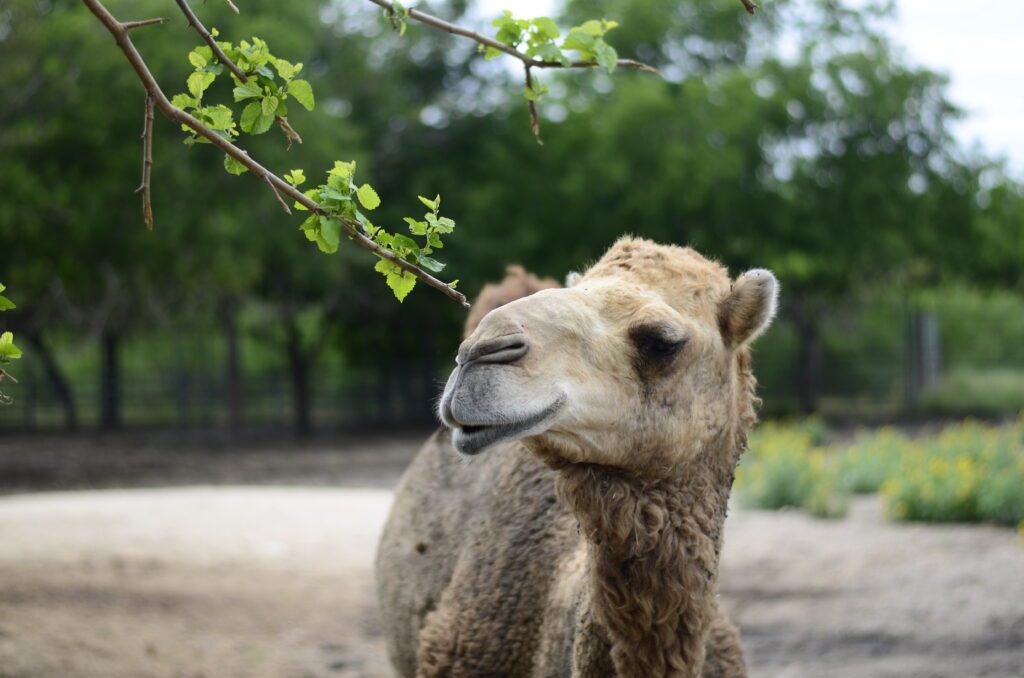This year, we will be kicking off our summer season in style by highlighting several new animal encounter experiences! During our unique animal encounters, we will be encouraging our guests to get up close and personal with their favorite animal ambassadors while learning more about them from one of our knowledgeable staff members. In addition to five brand new traditional animal encounter experiences, we will also be introducing guests to a feeding-based encounter that proudly features our dromedary camel residents! When you book a feeding with one of our camels, you can hand feed them all of their favorite treats while learning all kinds of fun facts about them!
Our camel feedings are quickly filling up. Book yours today while supplies last!
Visit the Zoo For Your Very Own Private Camel Feeding
Before you can swing by our zoo to meet our incredible camels during your camel feeding, here are some basic camel facts to better prepare you for this once-in-a-lifetime experience! For starters, there are three extant (or living) camel species: the one-humped dromedary camel, the two-humped Bactrian camel, and the critically endangered wild Bactrian camel. Of these three species, the dromedary camel is the most common, and is the sole camel species housed at Animal World & Snake Farm Zoo. Another interesting fact about dromedary camels is that they live in tight-knit communities that generally consist of 4-6 individuals. Like many other familial units composed of animals, the adult male takes charge while the adult female nurtures. This dynamic interestingly comes across when these tight-knit camel caravans travel! When traveling, the male displays his dominance by leading his family in the right direction.
Another fun fact about camels is that they are not born with their signature curved humps! Rather, newborn camels have limp humps that primarily consist of skin and hair. As camels age, their humps become more defined as they are filled with fat. This leads us to a widespread misconception about camel humps; while many people believe that camel humps are filled with water, they are actually filled with fat! This stored fat comes in handy when camels cannot access food and water. Like these nutrients, this fat gives camels energy and allows them to traverse their harsh environment as true “ships of the desert.” In fact, this stored fat enables camels to live up to six months without food or water! While these survival skills aren’t necessary for our dromedary camels, learning all about their incredible humps makes many of our guests appreciate them in a whole new light!
Fun Dromedary Camel Facts!
Here at Animal World & Snake Farm Zoo, we will soon begin offering exclusive camel feeding encounters that will encourage guests to get up close and personal with our magnificent camels. Because of this, we wanted to take this opportunity to share some fun facts about camel feeding habits! For instance, did you know that a camel’s diet primarily consists of foliage and dry grasses? While this may not come as a surprise since their natural habitat offers very little in terms of sustenance, many of our guests are shocked when they learn that camels are herbivores! Another interesting fact about camels is that, like cows, they are known to graze. Even though their harsh desert environment doesn’t contain the lush grasses that cows take advantage of on a daily basis, these ships of the desert are impressively adaptable and are able to make the most of their surroundings.
We may have already shared some fascinating camel facts, but there are plenty more where that came from! In addition to being known for their signature humps, camels were and continue to be reliable sources of transportation for nomadic communities. First domesticated in the Middle East over 4,000 years ago, the dromedary camel was frequently utilized to traverse long stretches of desert terrain due to its admirable adaptability. One of our personal favorite dromedary camel facts is that they can run up to 40 miles per hour. To put this in perspective, that is the same maximum speed of a racehorse!
Even More Camel Facts & Incredible Camel Pictures
Now that we have shared some fun facts about camel feeding habits, we wanted to share a few extra fun camel facts for kids! Since we have already debunked the widely believed misconception that a camel’s humps store water, here’s an interesting fact about their water intake. When a camel finds a fleeting desert oasis, it can drink up to 40 gallons of water in one go! One of our favorite camel facts to share with the kiddos is that there are over 160 words for “camel” in the Arabic language alone. To make this notion even more interesting, many of these Arabic words incorporate physical and behavioral descriptions as well! For instance, the word for “a strong male camel” varies from the word for “a camel that drinks little water.” I guess you can say that a camel is worth a hundred words— and that’s just in a single language!
As you look forward to your very own dromedary camel feeding experience, here are a few amazing photos of them in all their glory! We hope these camel pictures inspire you to visit the Zoo this summer to meet these majestic mammals in person!
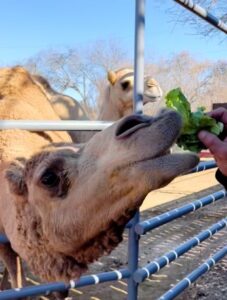
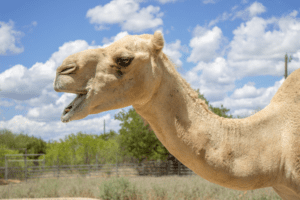
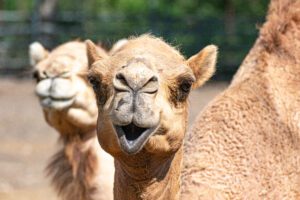
Book a Private Camel Feeding This Summer in Texas!
Make this summer in Texas even more special by meeting one of our remarkable dromedary camels up close and personal! During your very own camel feeding session, you can hand feed our camels some of their favorite snacks while learning even more about them. And that’s not all! If you are looking for a different encounter experience, we’ve got you covered! Whether you want to meet the fennec fox’s equally adorable cousin (the bat-eared fox) or discover how adorably tiny pancake tortoises are in person, there is sure to be the perfect animal experience for you at the Zoo this summer. Check out the fun graphic below for a quick look at some of the other animal encounter experiences we will be offering all summer long!
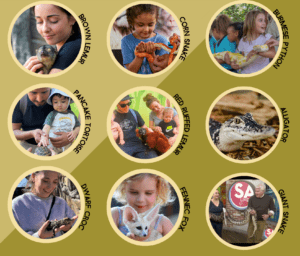
Follow us on Facebook to keep up with the adorable antics our animals get up to on a regular basis!

